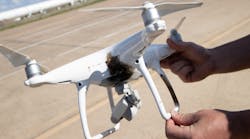This article is part of the TechXchange: Defense Electronics.
The first open-air testing of high-energy-laser (HEL) weapons in Texas was conducted recently by Raytheon, an RTX company, to demonstrate the effectiveness of such weapons across long distances against different types of tactical drones. Testing was performed at the Texas A&M-RELLIS campus of the George H.W. Bush Combat Development Complex (BCDC) and Innovation Proving Ground (IPG), located in Bryan-College Station, Texas.
Michael Hofle, senior director of high energy lasers at Raytheon, explained, “We see drone attacks having an out-sized impact in combat zones and even civilian settings, and they are extremely difficult to detect and defeat.” He noted that having a regional test facility for the 15-kW HELs (see image above), which are produced at Raytheon’s facility in McKinney, Texas, makes the technology accessible to the armed forces, “Having the ability to test our systems in our own backyard is a game changer for getting this technology into the hands of uniformed personnel quickly and affordably.”
Evaluations of the HELs had been performed in other facilities in other states prior to the availability of the IPG in Bryan-College Station. The complex’s labs offer a wide array of capabilities for collaboration among the defense industry, universities, government, and technology innovators.
John Sharp, chancellor of the Texas A&M University System, offered, “We are proud to collaborate with Raytheon on the latest technologies for national security. This is another example of the world-changing impact that Texas A&M-RELLIS will have for generations to come.” By having the IPG testing capabilities nearby, Raytheon can now design, produce, and test laser weapons in Texas.
Read more articles in the TechXchange: Defense Electronics.
